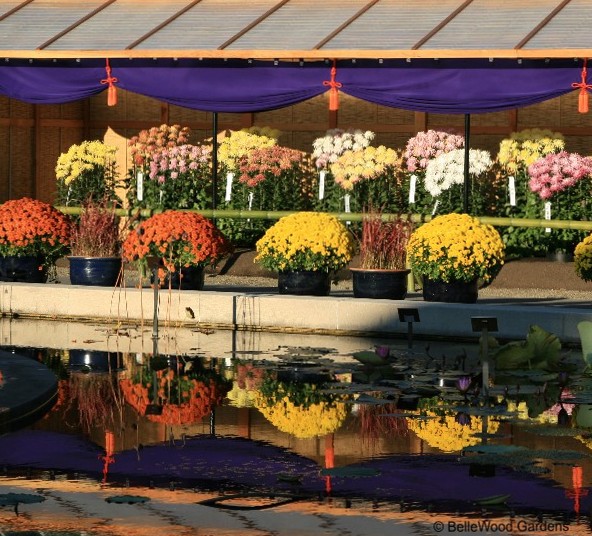
.
Thursday, 23 October 2008
An Evening Reception at the New York Botanical Garden
I received an invitation for this evening's reception at The New York Botanical Garden. It's a special event, to enjoy the kiku after dark. There will be refreshments, some entertainment, and a minimum of speeches by such august personages as the Japanese ambassador and the chairman of Mitsubishi. Why not? Another visit to see the magnificent chrysanthemums is hardly excessive. Again it was perfect weather with not a cloud in the sky or even a breeze to ruffle the leaves. I decided to leave home early, to arrive about 4:00 p.m. Good light and, hopefully, few other early birds so I'd have a clear field for pictures. As it turned out, the evening exceeded my expectations.

From under the sculpture of Clouds in the Bamboo Forest I can see
the uwaya or pavilion of shino-tsukuri, driving rain chrysanthemums.

The lower angle of the sun casts a warm glow over the scene
reflected in the waters of the tropical waterlily pool where one
blue flower defiantly in bloom, refuses to accept summers end.

These old style Edo chrysanthemums have three kinds of petals. Some are flat,
others are rounded, like a quill, and the third kind are spoon-like with an open tip.
As the flower ages, the flat center petals curl inward like a swirling pinwheel.
Variation in color further accents the flower's changing appearance.

Autumn is also the time for momijigari, when Japanese go to the countryside
to enjoy the autumn foliage of momiji, maples. The vibrant color of this Japanese maple
is further accented by Japanese blood grass, Imperata cylindrica 'Rubra' in the foreground.

Even bonsai, like this forest-style maple, respond to the changing season with vibrant color.

Maiden grass, Miscanthus, seemingly captures the light with its seed heads,
explanation enough as to why it is included as one of the seven plants of autumn.
By now people are arriving. Evening, also is arriving, and with the setting sun the air grows cool.
Candles glimmer along the curbing of the pools and lights illuminate the kiku in their uwaya.


Food and drink appears, with stations in the conservatory and outdoors in the courtyards.
Crisp crackers sprinkled with sesame seeds. A bite, the cracker shatter, then melts in my mouth.
Tiny pastry cups with diced chicken and spices. Endless platters of sushi with diverse fillings -
some with salmon, or a piece of pickle, avocado, and others. Blanched vegetables - asparagus,
thin baby green beans, snow peas - and guacamole seasoned with cumin.
A smaller dish with wasabi.
.
 As dusk fell samurai crept out from behind the hedges, their dark clothing melding with the night. It was their swords that caught the last of the light, glimmering like mercury.
As dusk fell samurai crept out from behind the hedges, their dark clothing melding with the night. It was their swords that caught the last of the light, glimmering like mercury.
.
This marvellous performance was created by Samurai Sword Soul
.
My description of their display of tate is taken from their web site.
Tate is fighting choreography using performers' bodies and weapons for stage and screen performances. The classical style appropriate for samurai drama uses bokken, wooden samurai wooden. Like stage combat, tate is acting, at one and the same time mimicking a weapon's cut or hit to opponents' bodies, but at the same time avoiding injury to the performers. It requires more than just the proper movement of the swords. Posture, footwork, and smooth action are also important. It also takes superb teamwork, with each performer using their interactive timing, techniques, and strength, to make the fighting scenes look real. .
Beautiful Warrior's movements flow. .
.
It is time for me to go. The drive back home is a long one. As I leave the conservatory
It is Masayo Ishigure and the Koto Ensemble Miyabi of Sawai Koto Academy of New York
I stand entranced, watching as harmonious sounds are created
All good things must come to an end.
This year you too have the opportunity to enjoy the kiku after dark,
Enjoy.
She dances with her two swords.

Warriors battle. Action. Reaction. Quick action without thought.
To pause and think would take too long.
Perhaps
it is a form of meditation.
All is ritual, down to the last detail of clothing.
Hakama are regularly worn by practitioners of a variety of martial arts, such as kendo, iaido, aikido, and kyu-do. These are divided, umanori or horse-riding hakama. Hakama are often considered particularly challenging to learn to fold properly of their pleats and also because their long ties must be correctly smoothed and gathered before being tied in specific patterns. It is an old tradition that the highest ranking student has the responsibility to fold the teacher's hakama as a token of appreciation.
I discover to my delight that the evening's events are not yet over. I hear music.
There are musicians playing on koto, Japan's traditional 13 string instrument. 
Finger picks on thumb, forefinger, and middle finger pluck the strings,
each string separately tuned with its own sliding bridge.
from these nearly six foot long instruments, nestled together
like a small school of very large fish.
The night still has some time remaining.
Better to leave now.
with Kiku and Cocktails on Friday October 31, November 7, and November 14,
from 6:00 to 8:00 p.m. Begin the night listening to a performance by
Taiko Masala drummers in the Visitor Center. Then stroll through the courtyards,
enjoying the kiku in their illuminated uwaya while listening to
traditional shakuhachi flute music. Beer, wine, and sake
will be available for purchase. And then finish the evening
with a Japanese meal at the Visitors Center Cafe.